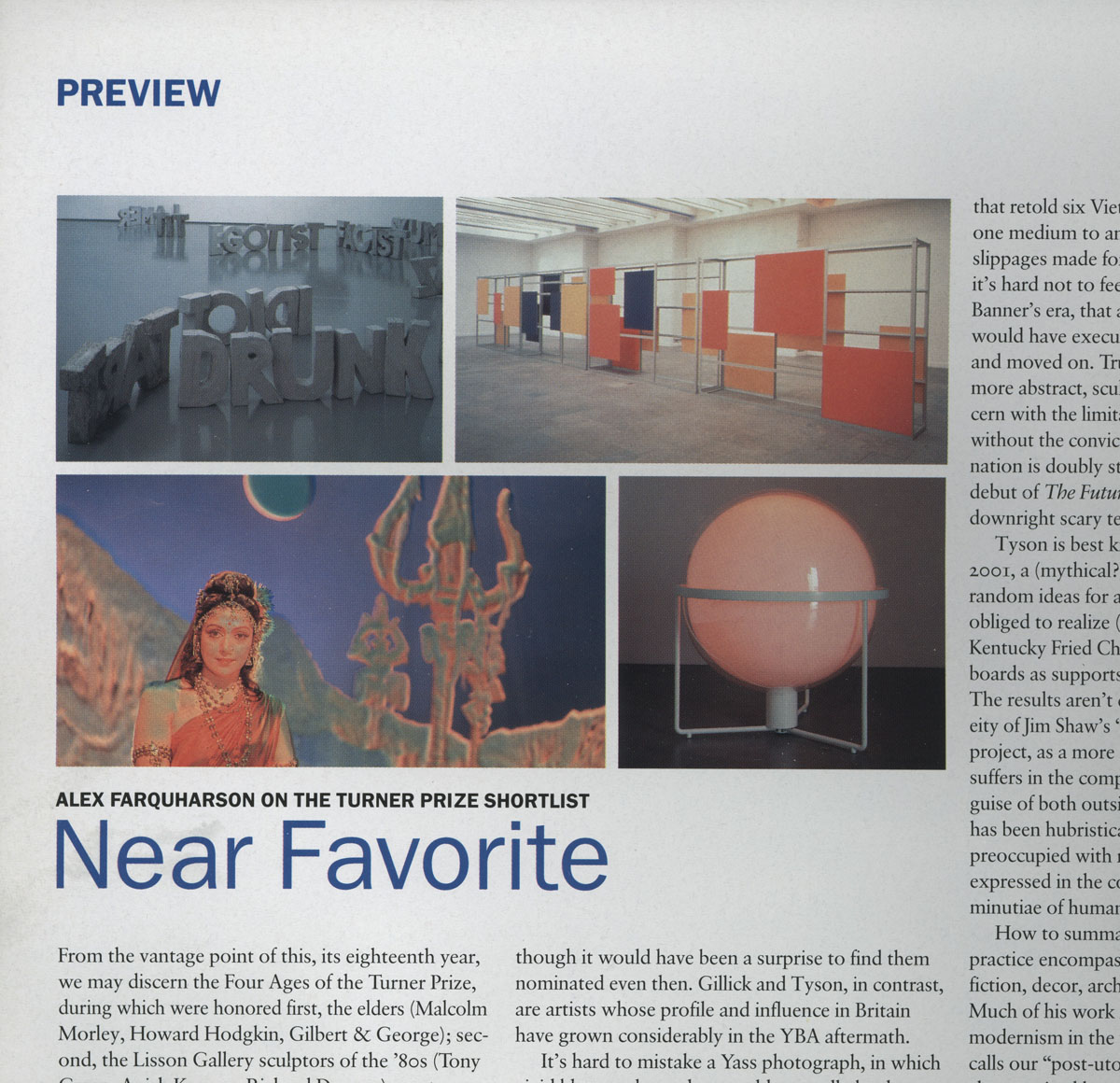Alex Farquharson is a London-based curator and writer.

From the vantage point of this, its eighteenth year, we may discern the Four Ages of the Turner Prize, during which were honored first, the elders (Malcolm Morley, Howard Hodgkin, Gilbert & George); second, the Lisson Gallery sculptors of the ‘80s (Tony Cragg, Anish Kapoor, Richard Deacon); next, and most famously, the YBAs (Rachel Whiteread Damien Hirst, et a1.); and of late, an unaffiliated, quieter variety of artist. For the past few years, with the exception of Martin Creed’s lights going on and off in 2001, the British tabloids have had little to get worked up about. The 2002 shortlist—Fiona Banner, Liam Gillick, Keith Tyson, and Catherine Yass—announced in late May, offers even less provocation, leaving one to wonder whether the Tate misses the media hysteria and the attendant box office or, having spectacularly achieved its goal of increasing audiences for contemporary art in Britain, instead welcomes this newfound serenity.
After last year’s selection—the strongest in some time—the current lineup looks curiously uneven. Banner and Yass are especially odd choices, being artists one associates with the mid-’90s, though it would have been a surprise to find them nominated even then. Gillick and Tyson, in contrast, are artists whose profile and influence in Britain have grown considerably in the YBA aftermath.
It’s hard to mistake a Yass photograph, in which vivid blues replace what would normally be the white areas of the image (an effect of developing a positive as a negative). Presented in the form of a light box (thank you, Jeff Wall), the backlit blues become religiously beautiful. Yass’s subjects are diverse-they include a psychiatric ward, cityscapes, art professionals, and Indian film stars-but one can’t escape the sense that content is secondary to style and that this style remains staggeringly unvaried, notwithstanding recent forays into film.
Banner made her name with a series of large text works in which she described in minute detail the plots of well-known films; that body of work culminated in The Nam, 1997, a thousand-page book that retold six Vietnam films. The transcription from one medium to another and the resultant subjective slippages made for something quite compelling, but it’s hard not to feel, as with many British artists of Banner’s era, that a first-generation Conceptual artist would have executed the idea once, gotten bored, and moved on. True, Banner has lately turned to more abstract sculptural ways of exploring her concern with the limitations of language-but somehow without the conviction of the earlier work. The nomination is doubly strange given that last year saw the debut of The Future from Memory, a truly epic and downright scary text work by rising Brit Emma Kay.
Tyson is best known for his Artmachine, 1991-2001, a (mythical?) device programmed to generate random ideas for artworks that the artist was then obliged to realize (casting the largest available Kentucky Fried Chicken meal in lead or using bread- boards as supports for 365 paintings, for instance).
The results aren’t dissimilar to the wild heterogeneity of Jim Shaw’s “Dream Objects,” though Tyson’s project, as a more obvious critique of authorship, suffers in the comparison. Of late Tyson, in the guise of both outsider artist and outsider scientist, has been heuristically, but somehow movingly, preoccupied with representing ideas of infinity as expressed in the cosmos, the subatomic and the minutiae of human consciousness.
How to summarize Gillick whose Deleuzian tactile encompasses sculpture, soundworks, film, fiction, decor, architecture, criticism, and curating? Much of his work revolves around the legacies of modernism in the urban environment in what he calls our “post-utopian situation,” His projects are characterized by radical openness, often operating in a middle ground between professional disciplines or in relation to artist collaborators (e.g., Philippe Parreno, Pierre Huyghe, and Jorge Pardo). Gillick has long been lionized by curators on the European mainland, and yet his recent solo shows at Arnolfini and Whitechapel were his first in public spaces back home. It’s a pity the prize this year doesn’t offer much in the way of competition (how Jeremy Deller didn’t make the cut for his extraordinary The Battle of Orgreave beggars belief), but Gillick more than deserves to walk home with the £ 20,000 this time around.